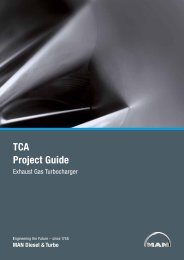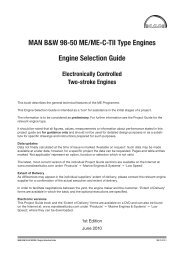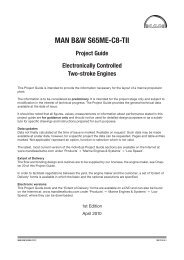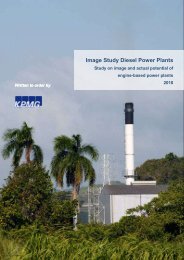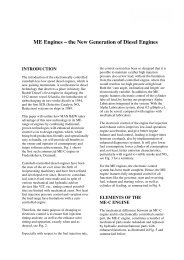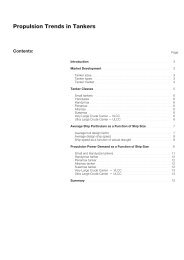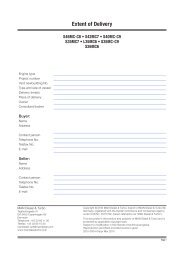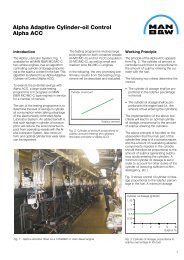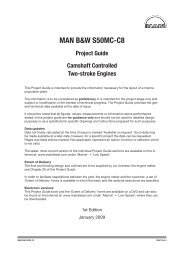This section is available on request - MAN Diesel & Turbo
This section is available on request - MAN Diesel & Turbo
This section is available on request - MAN Diesel & Turbo
You also want an ePaper? Increase the reach of your titles
YUMPU automatically turns print PDFs into web optimized ePapers that Google loves.
<strong>MAN</strong> B&W 16.01<br />
Engine C<strong>on</strong>trol System ME<br />
The Engine C<strong>on</strong>trol System for the ME engine <str<strong>on</strong>g>is</str<strong>on</strong>g><br />
prepared for c<strong>on</strong>venti<strong>on</strong>al remote c<strong>on</strong>trol, having<br />
an interface to the Bridge C<strong>on</strong>trol system and the<br />
Local Operating Panel (LOP). The LOP replaces<br />
the Engine Side C<strong>on</strong>trol c<strong>on</strong>sole of the MC engines.<br />
A Multi-Purpose C<strong>on</strong>troller (MPC) <str<strong>on</strong>g>is</str<strong>on</strong>g> applied as<br />
c<strong>on</strong>trol unit for specific tasks described below:<br />
ACU, CCU, ECU, and EICU. The c<strong>on</strong>trol units are<br />
all built <strong>on</strong> the same identical piece of hardware<br />
and differ <strong>on</strong>ly in the software installed.<br />
The layout of the Engine C<strong>on</strong>trol System <str<strong>on</strong>g>is</str<strong>on</strong>g> shown<br />
in Fig. 6.0 .0 , the mechanical�hydraulic system<br />
<str<strong>on</strong>g>is</str<strong>on</strong>g> shown in Fig. 6.0 .02, and the pneumatic system,<br />
shown in Fig. 6.0 .03.<br />
The present ME system has a high level of redundancy.<br />
It has been a requirement to its design that<br />
no single failure related to the system may cause<br />
the engine to stop. Furthermore, the ME system<br />
has been designed so that a single failure in most<br />
cases will not, or <strong>on</strong>ly slightly, affect the performance<br />
or power availability.<br />
Main Operating Panel (MOP)<br />
In the engine c<strong>on</strong>trol room a MOP screen <str<strong>on</strong>g>is</str<strong>on</strong>g> located,<br />
which <str<strong>on</strong>g>is</str<strong>on</strong>g> a Pers<strong>on</strong>al Computer with a touch<br />
screen as well as a trackball from where the engineer<br />
can carry out engine commands, adjust the<br />
engine parameters, select the running modes, and<br />
observe the status of the c<strong>on</strong>trol system.<br />
A c<strong>on</strong>venti<strong>on</strong>al marine approved PC <str<strong>on</strong>g>is</str<strong>on</strong>g> also located<br />
in the engine c<strong>on</strong>trol room serving as a<br />
back�up unit for the MOP.<br />
Engine C<strong>on</strong>trol Unit (ECU)<br />
For redundancy purposes, the c<strong>on</strong>trol system<br />
compr<str<strong>on</strong>g>is</str<strong>on</strong>g>es two ECUs operating in parallel and<br />
performing the same task, <strong>on</strong>e being a hot<br />
stand�by for the other. If <strong>on</strong>e of the ECUs fail, the<br />
other unit will take over the c<strong>on</strong>trol without any<br />
interrupti<strong>on</strong>.<br />
The ECUs perform such tasks as:<br />
Page of 8<br />
• Speed governor functi<strong>on</strong>s, start/stop sequences,<br />
timing of fuel injecti<strong>on</strong>, timing of exhaust<br />
valve activati<strong>on</strong>, timing of starting valves, etc.<br />
• C<strong>on</strong>tinuous running c<strong>on</strong>trol of auxiliary functi<strong>on</strong>s<br />
handled by the ACUs<br />
• Alternative running modes and programs.<br />
Cylinder C<strong>on</strong>trol Unit (CCU)<br />
The c<strong>on</strong>trol system includes <strong>on</strong>e CCU per cylinder.<br />
The CCU c<strong>on</strong>trols the electr<strong>on</strong>ic exhaust<br />
Valve Activati<strong>on</strong> (FIVA) and the Starting Air Valves<br />
(SAV), in accordance with the commands received<br />
from the ECU.<br />
All the CCUs are identical, and in the event of a<br />
failure of the CCU for <strong>on</strong>e cylinder <strong>on</strong>ly th<str<strong>on</strong>g>is</str<strong>on</strong>g> cylinder<br />
will automatically be put out of operati<strong>on</strong>.<br />
It should be noted that any electr<strong>on</strong>ic part could<br />
be replaced without stopping the engine, which<br />
will revert to normal operati<strong>on</strong> immediately after<br />
the replacement of the defective unit.<br />
Auxiliary C<strong>on</strong>trol Unit (ACU)<br />
The c<strong>on</strong>trol of the auxiliary equipment <strong>on</strong> the engine<br />
<str<strong>on</strong>g>is</str<strong>on</strong>g> normally divided am<strong>on</strong>g three ACUs so<br />
that, in the event of a failure of <strong>on</strong>e unit, there <str<strong>on</strong>g>is</str<strong>on</strong>g><br />
sufficient redundancy to permit c<strong>on</strong>tinuous operati<strong>on</strong><br />
of the engine.<br />
The ACUs perform the c<strong>on</strong>trol of the auxiliary<br />
blowers, the c<strong>on</strong>trol of the electrically and engine<br />
driven hydraulic oil pumps of the Hydraulic Power<br />
Supply (HPS) unit, etc.<br />
Engine Interface C<strong>on</strong>trol Unit (EICU)<br />
The EICUs installed in the engine c<strong>on</strong>trol room<br />
perform such tasks as interface with the surrounding<br />
c<strong>on</strong>trol systems, See Fig. 6.0 .0 . The<br />
two redundant EICU units operate in parallel.<br />
<strong>MAN</strong> B&W ME/ME�C engines 198 48 47�6.5<br />
<strong>MAN</strong> <strong>Diesel</strong>



